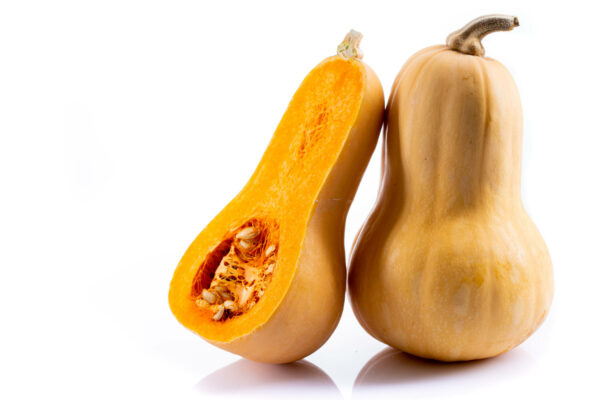Gladis Zinati, Ph.D.1,* and Lavanya Reddivari, Ph.D. 2 and Jinjun Kan, Ph.D.3
1Director of the Vegetable Systems Trial and Associate Research Scientist, Rodale Institute, 611 Siegfriedale Road, Kutztown, PA 19530;
2Associate Professor, Food Science, Purdue University, 745 Agriculture Mall Dr., West Lafayette, IN 47907;
3Associate Research Scientist, Stroud Water Research Center, 970 Spencer Rd, Avondale, PA 19311;
*Corresponding author, Email: Gladis.Zinati@RodaleInstitute.org
Find a downloadable PDF of this article by scrolling down to the “Resources” section.
 Winter squash is an important crop throughout the Northeastern U.S. In Pennsylvania, there are 868 acres devoted to winter squash on 602 farms. Three varieties of winter squash are dominating the commercial market including acorn (Cucurbita pepo), buttercup (Cucurbita maxima) and butternut (Cucurbita moschata).
Winter squash is an important crop throughout the Northeastern U.S. In Pennsylvania, there are 868 acres devoted to winter squash on 602 farms. Three varieties of winter squash are dominating the commercial market including acorn (Cucurbita pepo), buttercup (Cucurbita maxima) and butternut (Cucurbita moschata).
Health benefits:
Although each variety of winter squash has a unique nutritional profile they all tend to be rich in minerals, vitamins, and carotenoids. Researchers have documented a number of health benefits associated with butternut winter squash, which include:

- Carbohydrate in the form of sugars and starch are the major constituents of butternut squash flesh. Starch contributes to sugar content during enzymatic breakdown due to storage or cooking. It supports healthy blood sugar levels (low in sugar 4g/100g).
- It provides a good source of dietary fiber. It aids in digestion and supports healthy weight management.
- Most importantly, it boosts the human immune system as it is rich in antioxidants such as phenols, Vitamins (A, C, B1 and B6) and minerals including potassium (K), iron (Fe), manganese (Mn) and magnesium (Mg).
- It is rich in healthy carotenoids that gives the yellowish orangy color of the winter squash pulp.
Storage of butternut winter squash:
Similar to potato and sweet potato, winter squash is a great vegetable that can be stored up to 6-9 months in a cool dry storage area with ideal temperatures between 55 and 60 ◦F with relative humidity (RH) of 30% to 50%.
The long storage shelf life of butternut squash allows vegetable growers store cured fruits up to three months and reap an extended income during the off season. Additionally, storage and availability of butternut squash in the market benefit consumers by including this vegetable in their meals during Thanksgiving holiday and throughout the winter season.
Effect of storage on nutritional benefits:
Among cucurbits, researchers have documented that long-term storage of pumpkins increased the accumulation of phytonutrients such as lutein and carotene. These are components of carotenoids that give the yellow orange color of the winter squash pulp.
However, there is lack of information how growing methods may impact butternut winter squash phytonutrients at harvest and when stored for extended period of time.
Effect of management practices, systems and storage on butternut winter squash:
In Pennsylvania, butternut squash is grown either on beds covered black plastic mulch or in bare ground that requires multiple cultivations between rows to control weeds, which are usually practiced before the vines grow laterally.
The interesting relationship between phytonutrients and storage in pumpkins has led us to set up an investigation to obtain scientific information on the impact of postharvest storage period on the phytonutritional quality of butternut squash when grown under the above mentioned management practices and cropping systems.
The increased need for more sustainable regenerative management practices to enhance soil health and production of nutrient dense crops, butternut squash has been evaluated in Vegetable Systems Trial (VST) at Rodale Institute under reduced tillage and intensive tillage practices in organic and conventional cropping systems.
In the VST, butternut squash is grown in soil where the cover crop is tilled into soil with intensive tillage practice and beds formed and covered with black plastic. Squash plants are compared to those grown in soil with rotational reduced tillage where the cover crop serves as a mulch. With these two practices, the butternut winter squash ‘Waltham’ is grown in an organic cropping system where the cover crop (hairy vetch: cereal rye; 30:90 lb/acre) is terminated by using a roller crimper, and a conventional cropping system where the cover crop (cereal rye at 100 lb/acre) is terminated by applying glyphosate, a herbicide, to burn down the cover crop biomass before transplanting the squash seedlings. In a study supported by the Pennsylvania Department of Agriculture, we assessed the impact of the storage period (0, 30, 60 and 90 days) on nutrient quality after butternut squash was cured for 2-3 weeks after harvesting from VST.
In this web article we are reporting a snap shot of the results:
- Mineral nutrients: Mineral nutrients in butternut squash did not change with the storage period. However, the concentrations of nitrogen (N), phosphorus (P), sulfur (S), copper (Cu), boron (B) and Zinc (Zn) were statistically greater in the organically grown butternut squash than in the conventional squash. No significant difference in concentrations of K, Mg, calcium (Ca), Mn and Fe between organic and conventional squash. The B concentration level was greater in butternut squash grown with reduced tillage practice while Zn and Mn concentrations were greater in squash grown with intensive tillage practice.
- Total protein: Total protein level in organically grown squash was greater than in the conventional squash. The slight increase in proteins over storage period was not statistically significant. However, protein level was statistically greater in the intensive tillage practice than in the reduced tillage.
- Total phenols: Organically-grown squash had greater levels of total phenols than in conventionally-grown squash. There was no significant effect of tillage management practice on total phenols. However, as the storage period increased from 0-day to 60-day, total phenols declined by 20%.
- Carotenoids: Alfa-carotene level was 3 fold greater than lutein level. The carotenoids (lutein and alfa-carotene) in the conventional were greater than in the organic. The carotenoids in squash grown with reduced tillage practice were greater than those with intensive tillage practice. Lutein and alfa carotene levels increased as storage period increased between 0-day and 60- day storage. The increase in lutein was 2x more whereas the increase in alfa carotene was 3x more.
- Sugar: Sugar level in butternut squash was significantly greater in the covnetional than in the organic and increased with storage time by 50%.
In summary:
Storage period linearly reduced total phenols and increased carotenoid and sugar levels. No significant impact of storage on mineral nutrients and protein levels in butternut squash.
Cropping system: The Organic system increased levels of several mineral nutrients mainly N, P, S, Cu, and Zn, total protein, and phenols, whereas the conventional system increased the carotenoids and the sugar levels in butternut squash.
Tillage management: Carotenoid and B levels increased in reduced tillage practice, wheareas total protein, Mn and Zn increased in intensively grown butternut squash.
Thus, butternut squash conventional growers who practice intensive tillage can produce butternut squash rich in carotenoid and sugars and those nutrients will increase with storage. On the other hand, organic growers can sell consumers stored butternut squash rich with minerals, protein, and phenols (stored up to 30 days), and low in sugar.
